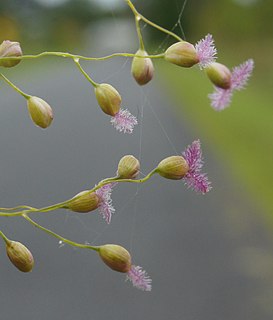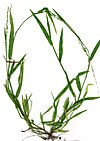
The Cyprinidae are the family of freshwater fish, collectively called cyprinids, that includes the carps, the true minnows, and their relatives. Also commonly called the "carp family", or "minnow family", Cyprinidae is the largest and most diverse fish family and the largest vertebrate animal family in general, with about 3,000 species of which only 1,270 remain extant, divided into about 370 genera. They range from about 12 mm to the 3-m Catlocarpio siamensis. The family belongs to the ostariophysian order Cypriniformes, of whose genera and species the cyprinids make up more than two-thirds. The family name is derived from the Ancient Greek kyprînos.

Poaceae or Gramineae is a large and nearly ubiquitous family of monocotyledonous flowering plants known as grasses. It includes the cereal grasses, bamboos and the grasses of natural grassland and species cultivated in lawns and pasture. The latter are commonly referred to collectively as grass.

Iridaceae is a family of plants in order Asparagales, taking its name from the irises, meaning rainbow, referring to its many colours. There are 66 accepted genera with a total of c. 2244 species worldwide. It includes a number of other well known cultivated plants, such as freesias, gladioli and crocuses.

The Muroidea are a large superfamily of rodents, including mice, rats, voles, hamsters, gerbils, and many other relatives. They occupy a vast variety of habitats on every continent except Antarctica. Some authorities have placed all members of this group into a single family, Muridae, due to difficulties in determining how the subfamilies are related to one another. The following taxonomy is based on recent well-supported molecular phylogenies.

The Elachistidae are a family of small moths in the superfamily Gelechioidea. Some authors lump about 3,300 species in eight subfamilies here, but this arrangement almost certainly results in a massively paraphyletic and completely unnatural assemblage, united merely by symplesiomorphies retained from the first gelechioid moths.

The Crambidae are the grass moth family of lepidopterans. They are variable in appearance, the nominal subfamily Crambinae taking up closely folded postures on grass stems where they are inconspicuous, while other subfamilies include brightly coloured and patterned insects which rest in wing-spread attitudes.

Panicoideae is the second-largest subfamily of the grasses with over 3,500 species, mainly distributed in warm temperate and tropical regions. It comprises some important agricultural crops, including sugarcane, maize, sorghum, and switchgrass.

Centotheceae is a small tribe of grasses with six species in two genera, distributed in Africa and Asia. It belongs to a basal lineage in subfamily Panicoideae, sometimes referred to as "centothecoid clade". Unlike many other clades in the subfamily Panicoideae, they use the C3 photosynthetic pathway.

The Satyrinae, the satyrines or satyrids, commonly known as the browns, are a subfamily of the Nymphalidae. They were formerly considered a distinct family, Satyridae. This group contains nearly half of the known diversity of brush-footed butterflies. The true number of the Satyrinae species is estimated to exceed 2400.

The family Stylidiaceae is a taxon of dicotyledonous flowering plants. It consists of five genera with over 240 species, most of which are endemic to Australia and New Zealand. Members of Stylidiaceae are typically grass-like herbs or small shrubs and can be perennials or annuals. Most species are free standing or self-supporting, though a few can be climbing or scrambling.

The BOP clade (sometimes BEP clade) is one of two major lineages (or clades) of undefined taxonomic rank in the grasses (Poaceae), containing more than 5,400 species, about half of all grasses. Its sister group is the PACMAD clade; contrary to many species of that group who have evolved C4 photosynthesis, the BOP grasses all use the C3 photosynthetic pathway.

The Aristideae is the sole tribe of grasses in the monotypic subfamily Aristidoideae of the true grass family Poaceae. Its members are herbaceous annuals or perennials found in the tropics, subtropics and temperate zones. The tribe has over 300 species in three genera: The subfamily is a member of the PACMAD clade of grasses, the evolutionary group in which C4 photosynthesis independently evolved a number of times.

Oryzoideae (syn. Ehrhartoideae) is a subfamily of the true grass family Poaceae. It includes around 120 species in 19 genera, notably the major cereal crop rice. Within the grasses, this subfamily is one of three belonging to the species-rich BOP clade, which all use C3 photosynthesis; it is the basal lineage of the clade.

The Puelioideae is a subfamily of the true grass family Poaceae with two genera, Guaduella and Puelia, each in its own tribe. Its members grow in the understory of rainforests.
Anomochlooideae is a subfamily of the true grass family Poaceae. It is sister to all the other grasses. It includes perennial herbs that grow on the shaded floor of forests in the Neotropics. There are two genera, Anomochloa and Streptochaeta, each in its own tribe.

Danthonioideae is a mainly southern hemisphere subfamily of grasses, containing the single tribe Danthonieae and one unplaced genus, with altogether roughly 300 species. It includes herbaceous to partially woody perennial or annual (less common) grasses that grow in open grasslands, shrublands, and woodlands. It belongs to the PACMAD clade of grasses, but unlike some other lineages in that clade, grasses in the Danthonioideae exclusively use the C3 photosynthetic pathway. Its sister group is the subfamily Chloridoideae.

The PACMAD clade (previously PACCMAD, PACCAD, or PACC) is one of two major lineages (or clades) of the true grasses (Poaceae), regrouping six subfamilies and about 5700 species, more than half of all true grasses. Its sister group is the BOP clade. The PACMAD lineage is the only group within the grasses in which the C4 photosynthesis pathway has evolved; studies have shown that this happened independently multiple times.

Colubroidea is a superfamily of snakes in the clade Colubroides that include Colubridae and a few other related families. Historically, Colubroidea also included other caenophidian snakes such as cobras and vipers, as these snakes form a clade. However these groups are now divided into several distinct, but related, families. Zaher et al. (2009) proposed to redefine Colubroidea for colubrids and related families, while designating Colubroides as the group containing vipers and cobras as well as colubroids.

Micrairoideae is a subfamily of the grass family Poaceae, distributed in tropical and subtropical regions. Within the PACMAD clade, it is sister to subfamily Arundinoideae.

Paspaleae is a tribe of the Panicoideae subfamily in the grasses (Poaceae), native mainly to the tropical and subtropical Americas but with a number of species introduced to other regions. It includes roughly 680 species in 39 genera. Species in this tribe use either of the C3 or C4 photosynthetic pathways.




















